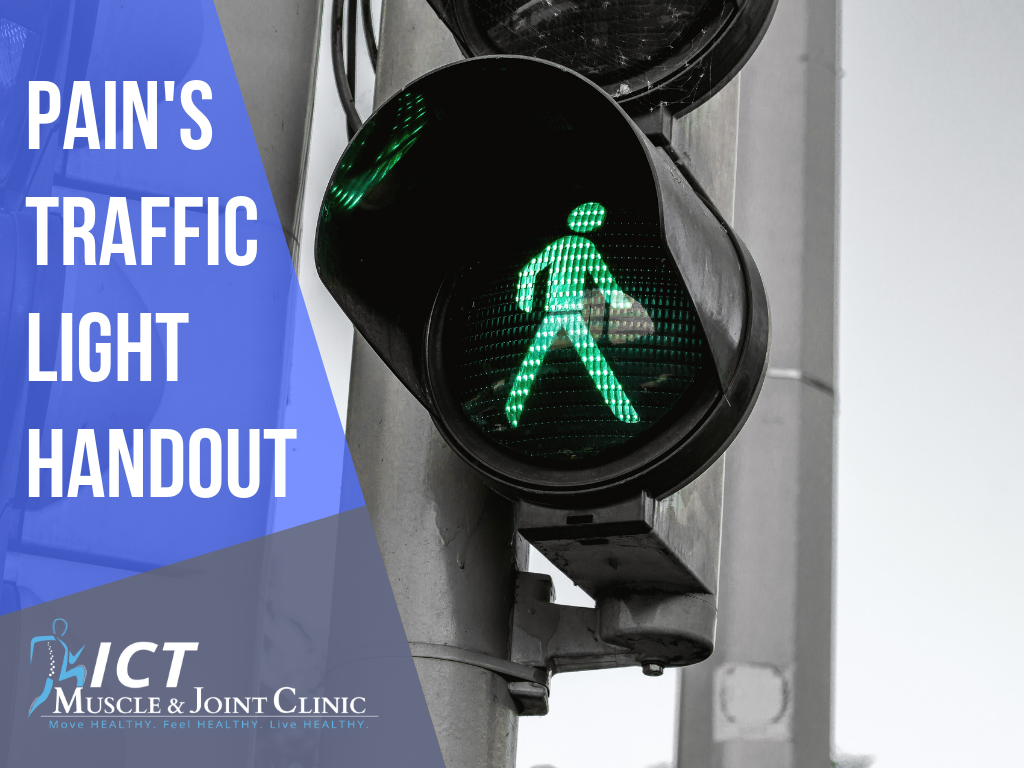Pain's Traffic Light Handout
Navigating through pain can be frustrating. This traffic light handout’s goal is to help you understand WHEN to perform your exercises based on your pain symptoms.
RED LIGHT FOR PAIN
Red lights are obvious. If something gets worse, then stop. Worse is when pain or symptoms move away from the area we discussed (ie knee, low back). Two factors we monitor for all lights are direction of symptom movement, and intensity of symptoms. If your symptoms are less intense (2/10 pain vs 5/10 pain with 10/10 pain being the worse pain ever) but cover a larger area of the body, then this is a red light. Reduction of pain is only positive if it stays in the same location or moves toward the area we discussed.
Red light example:
A good example of a red light is a person experiencing Sciatica from a disc herniation. If your back pain become less intense after moving it in a certain direction AND your symptoms move further down your leg, then this is a red light. We want symptoms to move toward the low back, even if they may become more intense in the low back during the early phases of healing or recovery.
YELLOW LIGHT FOR PAIN
Yellow lights are for caution. A yellow light indicates things aren’t worse or better. Yellow lights are for when we move in a direction and the pain or symptoms stay in the same area(s) – symptoms do not move. The way we identify if the direction, we discussed in office, is correct is by loading (moving) that direction enough times to make it a red light or green light. A yellow light becomes red when your symptoms move away from the area we have discussed. A yellow light becomes green when your symptoms start to move toward the area we have discussed. Understanding HOW MUCH to move is equally important here.
GREEN LIGHT FOR PAIN
Green lights make us all happy! Hopefully we have found the right combination of things to identify a green light in the first 3-5 visits. Often, we can find it in 1 visit, however there are times when someone may be too inflamed in the beginning and need to follow appropriate steps to reduce the inflammation first. If we don’t follow that step first, then we may make things worse. After all, the goal is to only make things better.
A green light is when we move in the correct direction enough times that symptoms start to centralize and/or decrease in intensity and/or increase your range of movement before symptoms are felt. It’s wonderful when all 3 happen simultaneously but that is not always the case. Movement can be our friend, not the enemy.
WHAT ELSE CAN I DO?
Understanding how to navigate using these traffic lights will allow us to maximize results during your visits. If you have questions over this, call us! We are always here for you! Follow the links on this blog to better understand other aspects of how to help your self at home.
About the author
Dr. Keith Sparks is an award-winning chiropractor, functional medicine expert, and the co-founder of ICT Muscle & Joint Clinic. Dr. Sparks’ emphasis of care originated within the fields of rehabilitation, soft-tissue therapies, and chiropractic. To date, he has brought this unique combination of skills into union with functional medicine. The sole purpose of intertwining these distinct skills, knowledge, and services is to provide incomparable care to his local community. Dr. Keith Sparks is often seen in the Wichita, KS community speaking at business events and teaching health and performance classes.
